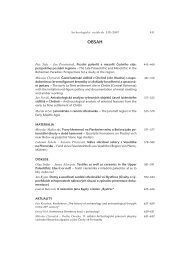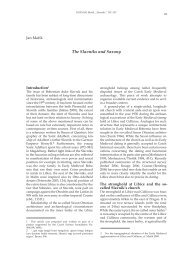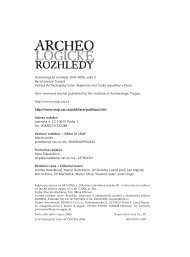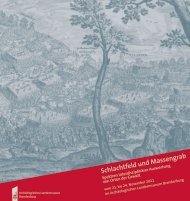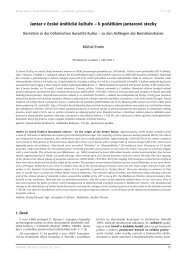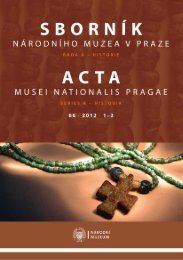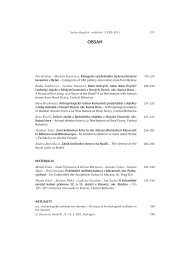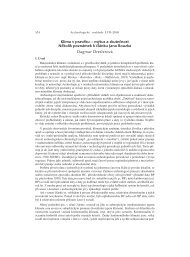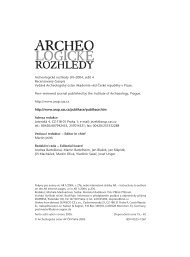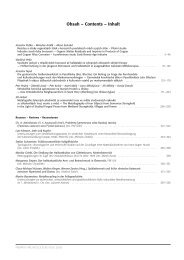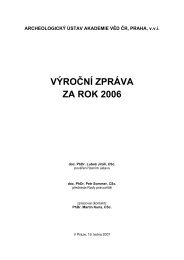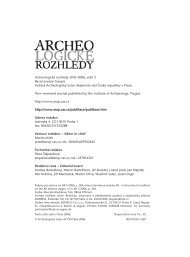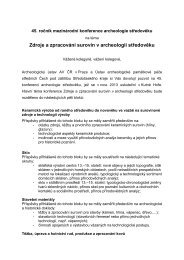138JEÎEK –CHYTRÁâEK –LOJEK –PROKOPOVÁ: Kpre-historii dvou Mûst praÏsk˘chPrague New Town connect traces of deliberate and non-disruptive liquidation – records of fill afterthe removal of structural elements, which is proof of the realization of a project of extraordinarydimensions and set rules. The destruction of costly buildings, including palatial stone buildings, atthe site of today’s square/náměstí Republiky along with subsequent terrain modifications raises questionsconcerning the property circumstances in the Prague agglomeration at the time. We connectthe liquidation of the secular development in this part of the Prague right-bank agglomeration withthe founding of Prague’s [Old] Town, which is evident at the beginning of the 1230s. Written sourcesfrom the time clearly show the efforts of non-monastic convents to move to a space protected by townwalls, which had left the former integral part of the right-bank Prague development outside of theirprotection and outside the range of town law. If in February 1233 the widowed Queen Constancia wascontemplating the establishment of a Cistercian convent at the Church of St. Peter (fig. 1: 3), whichhad been the church of the Prague Germans earlier and which Constancia had bought (in 1233) fromthe Teutonic Knights, the royal intention at the beginning of the 1230s to isolate the area surroundingthe Church of St. Peter and the Church of St. Clement from city activity was already a certainty. Thelegal property context and the timeline for the realization of such a plan remain a question though.Sources do not allow more precise dating than to the 1230s and 1240s.The assemblage of three intact ceramic vessels and two large fragments (fig. 7: 1–4) from thepreserved part of the cesspit (5b) date the fill to the 14 th century. The fill of the cesspit also contained335 fragments of hollow glass (fig. 8: 1, 3, 4, 7, 8), which illustrate the level of dining ofhouseholds, which for Prague standards were certainly not economically above average. Althoughwritten sources indicate that in this area beneath the walls of the [Greater, later Old] Town of Prague –which until that time had been deserted – extensive construction activity began around the turn of the14 th century (especially under the direction of several wealthy Prague burghers), no traces of suchactivity have yet been recorded, despite intensive archaeological excavations that have taken place.Not even the presented assemblage of ceramics and glass from the cesspit allows us to determinewith certainty whether it stems from the first or second half of the 14 th century: from a householdin the periphery areas of Greater [Old] Town or from a house of the first occupants of Prague’s NewTown (founded in 1348).English by Robin CasslingMILOSL<strong>AV</strong> CHYTRÁČEK, <strong>Archeologický</strong> <strong>ústav</strong> <strong>AV</strong> <strong>ČR</strong>, v.v.i., Letenská 4, CZ-118 01 Prahachytracek@arup.cas.czMARTIN JEŽEK, <strong>Archeologický</strong> <strong>ústav</strong> <strong>AV</strong> <strong>ČR</strong>, v.v.i., Letenská 4, CZ-118 01 Praha; jezek@arup.cas.czTOMÁŠ LOJEK, Stilus – služby pro vědu a výzkum, v.o.s., Havlíčkova 781, CZ-267 51 Zdicetomas.lojek@seznam.czANNA PROKOPOVÁ, Ústav pro pravěk a ranou dobu dějinnou FF UK, Celetná 20, CZ-116 36 Prahaprokopovaa@seznam.cz
<strong>Archeologické</strong> <strong>rozhledy</strong> LXI–<strong>2009</strong> 139AKTUALITYJUBILEUM KONFERENCE THEORETICAL ARCHAEOLOGY GROUPVe dnech 15.–17. prosince 2008 se uskutečnil jubilejní30. ročník britské konference s mezinárodníúčastí Theoretical Archaeology Group. Jakožto britskánárodní instituce byla TAG ustavena v r. 1979 sezáměrem přinášet a diskutovat teoreticky zaměřenátémata v archeologii (A. Fleming – M. Johnson:The Theoretical Archaeology Group /TAG/ origins,retrospect, prospect. Antiquity 64, 1990, 303–306).Od té doby pořádá tato skupina každoroční konferenci,kterou hostí různá univerzitní prostředí Spojenéhokrálovství (viz http://antiquity.ac.uk/tag/index.html). V posledních letech se konference pořádá takéve skandinávských zemích a v USA. Pro 30. ročníkbyly zvoleny prostory univerzity v jihoanglickémSouthamptonu, kam zavítaly stovky archeologůz celého světa.Konference byla zahájena plenární sekcí s názvem1968–2008: The Spirit of Rebelion, 40 YearsOn, v jejímž rámci pořadatelé i účastníci diskutovaliotázky vztahu archeologie a sociální a politickésféry: zejména vliv politických a sociálních revolucí60. a 70. let 20. stol. na archeologickou teoriii praxi, možnosti archeologického studia revolučníchudálostí, současný vztah archeologického myšlenía výzkumu a sociálních a politických hnutí, rolearcheologie v současných hlavních socio-politickýchudálostech. Diskuse se týkaly především prostředízápadní Evropy (Spojené království, Francie). Témasouviselo chronologicky s výročím událostí v r. 1968asuniverzitním prostředím Southamptonu také např.díky kontroverznímu ročníku World ArchaeologicalCongress, který se tu konal v r. 1986.Během následujících dvou dnů bylo uskutečněnocelkem 39 sekcí velmi různého zaměření: destrukce,experiment, fragmentace, gender, historieoboru, hranice, identita, interpretace, krajina, materiálníztvárnění, metodologie, mezioborová spolupráce,okupace, památková péče, počítačová podpora,pohřební ritus, popularizace, rituál, sociálnía materiální paměť, symbolika, terénní výzkum,vztah archeologie a veřejnosti; dále sekce věnovanéspecifickým regionům či chronologickým obdobím.Naprostou většinu sekcí připravili britští archeologové,objevily se však také sekce organizované odborníkyze Španělska, Portugalska, Dánska či Indie.V rámci těchto sekcí bylo předneseno více než 300příspěvků (seznam i s abstrakty viz http://www.tagconference.org/sessions). Většina příspěvků opět patřiladomácí produkci (226), zahraniční bádání představiliodborníci z USA (11), Portugalska (6), Indie(5) a z dalších států Evropy, Ameriky (Kanada) a Asie(Turecko, Irán). Českou republiku reprezentovalaKatedra archeologie Západočeské univerzity v Plzni.Třicátému výročí bylo věnováno volné setkání,vzpomínání, projekce filmových záznamů a komentovánízajímavých a významných etap a událostív historii TAGu, s názvem Personal Histories of TAG:30 Years On, které uspořádaly významné osobnostibritského teoretického bádání (A. Fleming, C. Renfrew,T. Champion, T. Darwill, C. Gamble). Sekce,jichž se autor zúčastnil, lze hodnotit jako velmizdařilé. Kromě výše zmíněných se jednalo zejménao celodenní sekce věnované studiu náboženstvív rámci krajiny – Finding Faith in the Landscape(zde autor přednesl příspěvek The Concept of SacredMountains in Czech Prehistory) či možnostem interpretacerituálního chování v minulosti – BeyondMeta-level Explanations of Ritual. Přednášející sesnažili prezentovat nová, mnohdy i lehce provokativníči kontroverzní stanoviska. Publikum projeviloschopnost podnětné diskuse vedené v otevřenéma přátelském duchu. Účastníci těchto sekcí se shodlipředevším na nutnosti návratu k detailnímu teoretickémui empirickému studiu konkrétních archeologickýchkontextů z hlediska náboženských, kultovníchči rituálních aspektů, na jehož základě lzespolehlivěji studovat strukturní jevy a vyjadřovat semnohem spolehlivěji k jejich interpretaci. Při studiuposvátných míst přírodního či artefaktového charakteruje také efektivní odhlédnout od monografickéhozaměření na jednotlivé lokality a věnovat se jejichcelkovému krajinnému kontextu.Kromě sekcí s odbornými příspěvky proběhlyv prostorách univerzity také další doprovodné akce,mezi něž patřila expozice výtvarných děl VisualBiographies: object, art and archaeological practice,tradiční kvíz časopisu Antiquity či večerní partya řada hudebních vystoupení. Také různé organizacevěnující se edukační činnosti, památkové péči,feminismu apod. zaujaly strategická stanoviště k nabídcekonzultací a propagačních materiálů. Užitečné(zejména z pohledu studenta) byly zvýhodněné



